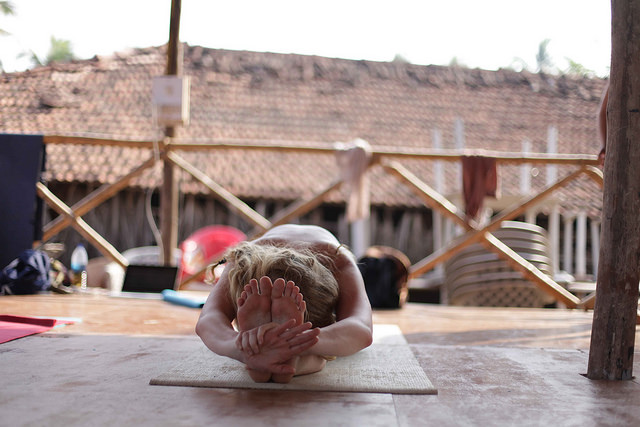It is often said in jest that Ashtanga vinyasa is addictive.
The thing is, it really can be. And while it is clearly less harmful than heroin or cigarettes, any addiction robs your life of presence and joy. Here are some ways you will know you are addicted to your spiritual practice, and what to do about it.
1) You obsess about your practice throughout the day, and rush your time with loved ones so you can “fit it in.”
Attempting to fit in an hour and a half practice six days a week, while also having a family (including a four and one year old) and a full-time demanding job, means that I squeeze the rest of my life so I can get it in. This often means that I rush breakfast with the kids after practice, or time with my husband at night so I can get enough sleep.
Now, when I notice that I am not present, I remind myself of what practice is for, being more present in my life. I take a breath, enjoy the smiling faces of my loved ones, and remind myself that an hour morning practice (or even 20 minutes) with a life fully lived is better than an hour and a half rushing.
2) The way you eat, sleep and work revolve around your practice, and it doesn’t feel right.
You must be vegetarian. Really. You must. And you try, but it doesn’t feel right. And your husband’s steak looks amazing. And you read the Omnivore’s Dilemma and you don’t really think vegetarianism makes that much sense to you. But you try anyways, because that’s what the yogis do. And when you eat meat you feel guilty, so your try again. Fail to thrive, again. And the cycle continues…
I wrote about my journey in vegetarianism here.
Today, I choose to tune in to what my body needs to eat in each moment, and I am seldom wrong. When I am, I notice and make a better choice next time. Ultimately I decide what I eat, and I know what’s best for my body. No Ashtanga police will take that away.
4:30 in the morning? Really? That means only six hours of sleep—if I can rush and make it to bed by 9:30, maybe seven…but I really need eight to function (and not get depressed). I tried and tried to sacrifice sleep for yoga but it just didn’t work. Now, I wake up a bit later and do a shorter practice with deep focus and intention. I work better, live better and have some time to enjoy time my husband after putting the kids to bed.
3) You are doing it because you will be better when…
Supta Kurmasana: the promise (I wrote about that here). Then the backbending, then second series. But really, where am I going? I have this idea that life will just get so much better when I can do all those fancy moves Kino does in her videos. But, probably, I will never do them. Does that make me a bad person? A lesser person? A less enlightened person? I am starting to think: no. What my body can do has nothing to do with who I am as a person. And that is real freedom that no jump-back can give me.
4) You feel “not whole” without practice.
Moon days, Saturdays and “ladies holiday” are a no no for practice. The thing is, those days that I look forward to I end up feeling down. I crave the practice, and don’t know what to do with my lethargic states of mind.
In comes mindfulness meditation, where I began my spiritual journey to begin with. Turns out that in mindfulness, we meet these difficult states right where we are. No need to do fancy poses so we can get our energy flowing in a particular way and feel lighter or more “sattvic.” Instead, we inundate the bad feeling with awareness, compassion and presence, and it all becomes more bearable, interesting even.
5) You practice mechanically, sometimes even through injury, rather than tuning in to what you need.
In my recovery from an eating disorder, I first went to Overeaters Anonymous. There I was told that I was “powerless” over food, and gave up sugar for three years. The thing is, it was not until I could face my fear of sugar (and other foods), that I could see I was using them to fill a void, and I became able to eat for nourishment and attend to my emotional needs in other ways. I was able to truly recover from my addiction.
In my yoga practice, we are told “practice, practice and all is coming.” Don’t think too much, just do. Yet to truly begin to reap the benefits of my practice, I feel that it needs to come from a deep, deep place. A place where no one knows what is right, except me.
Recovery from Asthanga addiction, for me, will involve choosing the path of tuning in to how I am in each moment, and seeing the kind of practice I need that day. I will let go of external measures of what is correct and tune in to the deepest voice within, the one that knows I’m already whole, and the practice is merely an expression of that wholeness.
Love elephant and want to go steady?
Sign up for our (curated) daily and weekly newsletters!
Author: Paula Vital
Editor: Catherine Monkman
Photo: The Yoga People/Flickr


 Share on bsky
Share on bsky




Read 15 comments and reply